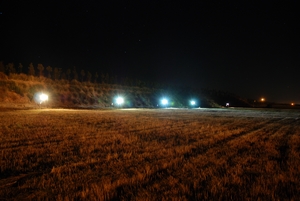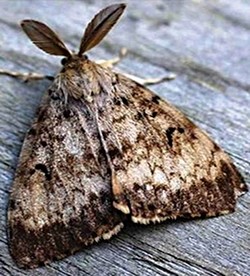City lights, bright nights

The world is more brightly lit now than ever before, spilling light pollution out into the night skies, with the glows on the horizon becoming progressively whiter and brighter.
Bright, energy saving LED lamps (light emitting diodes) are the new white when it comes to lighting. With their many advantages over incandescent lights, such as lower energy consumption, longer lifetime, robustness, smaller size and faster switching, LEDs are increasingly being used for municipal and industrial purposes.
At first, entomologist Dr Steve Pawson wanted to find out what effect the harsh, white LED light was having on insects compared to the softer yellow hues of traditional high-pressure sodium lamps (HPS), and what this might mean for the forestry industry and log marshalling sites at ports. He then started getting enquiries from those in the food production industry who were experiencing an increasing number of unwelcome insect pests being drawn to their sites, and he realised the issue was much broader.
“Insects demonstrate different abilities to detect light depending on their vision, however most insects respond strongly to light in the blue and UV spectra,” explains Steve. “And current white LED lights are based on monochromatic blue LEDs coated with a phosphor coating. The phosphor coating can be manipulated to produce a range of ‘white’ lights that are referred to by their colour temperature – the greater the proportion of blue light emitted, the higher the colour temperature.
“The growing trend for industries to change to more cost effective LED lighting could have a huge effect on how insects and animals respond and behave and could potentially alter ecosystem processes.”
While the bright lights of the city’s industrial sites may hold a strong attraction for insects, there is growing evidence to suggest their effects may be more widely spread among terrestrial animals. As Steve explains, behaviours that are influenced by vision could change creating a significant ecological impact both for individual species and the interaction between species, such as predator avoidance or prey detection, navigation, pollination or foraging.
To investigate this further, Steve and his team conducted a comparison between the effects of LED and HPS lighting at an industrial scale, using different colour temperatures of LED lights. This research was recently published by the Ecological Society of America.
Their results showed that LED lamps attracted 48% more flying insects on average than HPS lamps, irrespective of the colour temperature of the LEDs. “Our results imply that careful selection of LEDs on the basis of their colour temperature is not likely to influence the ecological impacts of a broad-scale shift to white LED lighting by industries,” says Steve. “The nuisance value of attracting unwanted pest species needs to be carefully considered when choosing industrial lighting but more importantly, the potential for white LEDs to increase phytosanitary and biosecurity risks that could snowball to other ecological impacts.”
“Our results imply that careful selection of LEDs on the basis of their colour temperature is not likely to influence the ecological impacts of a broad-scale shift to white LED lighting by industries,” says Steve. “The nuisance value of attracting unwanted pest species needs to be carefully considered when choosing industrial lighting but more importantly, the potential for white LEDs to increase phytosanitary and biosecurity risks that could snowball to other ecological impacts.”
As an example, the gypsy moth (Lymantria dispar) is more attracted to white lights than to light from HPS lamps. Gypsy moth is a voracious and invasive forest pest and the ecological ramifications of it establishing in new regions are severe. Ships infested with egg masses laid by moths attracted to lights are a known pathway, and therefore a transition to white LEDs at, or near, ports may elevate the risk of egg masses being spread and establishing gypsy moth in new areas.
Where to from here?
Light pollution is recognised as a global threat to the conservation of biological diversity. This is likely to be magnified by the growing trend to use phosphor-coated LED lamps for industrial and municipal purposes.
According to Steve, it is imperative for us to fully understand the possible long term ramifications of white LED lights on ecological communities, populations and species and the associated implications for biosecurity. Further research is necessary to achieve this.
“A comprehensive assessment of overall impacts and knowledge about the influence of each region of the visible spectrum will allow lighting engineers to work with ecologists to focus future developments in lighting technology that balance the needs of illumination and energy efficiency while minimising ecological impacts”.
